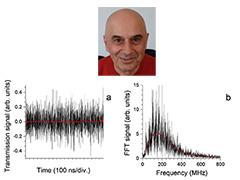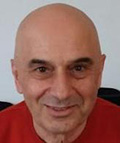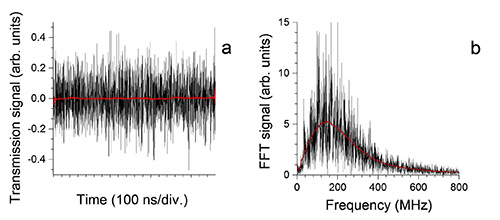| ||||||||
In a laser light field, an atom periodically absorbs and emits photons, passing from one state to another (so-called "Rabi oscillations"). In an atomic media (in gas, where the number of atoms is millions), Rabi oscillations can be recorded at the moment of abrupt switching-on of the laser field, after which they gradually fade, and a stable state is formed ("steady-state" interaction regime). At present this mode has been studied in detail and serves a basis for various valuable applications. "The performed experiment is extremely simple at first sight: laser radiation passes through the rubidium atomic vapor, and the transmitted light is recorded by a photoreceiver. A low-speed photodetector is traditionally used to record steady-state processes, resulting in a time-invariant recorded signal. For the first time, aiming to solve the problem, we have used a high-speed and sensitive photoreceptor which is capable of detecting signal changes in an ultra-short time scale (<10-9 seconds). Instead of an unchanging signal, abrupt oscillations of the signal, which at first sight seem to be random, were immediately registered. The analysis of the oscillating signal with the "fast Fourier transform" processing has shown that the average frequency of the oscillations is consistent with the Rabi frequency corresponding to the given intensity of the laser. The result seems to be surprising as we are dealing with continuous laser light. Here comes a question: to what extent of continuity is the radiation that is considered to be "continuous"? In fact, any laser is imperfect, its radiation is subject to phase discontinuities, as a result of which the monochromaticity is disrupted to some extent. It was confirmed in the experiment. We have used two different lasers, and the signal oscillations were larger in the case of a laser with a larger spectral width. In other words, "it is possible to describe the "quality" of laser radiation in a simple experimental way"", said Aram Papoyan. Directly recorded rubidium vapor resonant release signal (a) and corresponding fast Fourier transform spectrum (b). Red curves are average signals. The picture is taken from the article: A.Papoyan, S.Shmavonyan, "Signature of optical rabbi oscillations in transmission signal of atomic vapor under continuous-wave laser excitation", Optics Communications, v.482, 126561 (2021).
The initial result was obtained by Aram Papoyan and Svetlana Shmavonyan, a Senior Researcher at the Institute for Physical Research of NAS RA. In 2021, research was carried оut to study the phenomenon in ultra-narrow optical cells. Armen Sargsyan, a young researcher at the Institute for Physical Research of NAS RA and Rodolphe Momier, a student at the University of Burgundy Franche-Comté in France, studying at the Institute under the internship program, were involved in the research. The experiments will be continued during the French student's next visit to Armenia, by that time in the status of a joint postgraduate student. The result of the research was published in 2021 in the authoritative international journal "Optics Communications" (impact factor - 2.125). To date, positive feedback has been received on this scientific result from authoritative experts in the field: I. Novikova (USA), Ch. Adams (Great Britain), D. Budker (Germany), A. Akulshin (Australia), M. Auzinsh (Latvia). The research was carried out within the framework of the project 18T-1C234 "Control of atomic populations in alkali metal vapors in a non-stationary resonant interaction regime" (2018-2020) under thematic funding of the Committee of Science of the Ministry of Education, Science, Culture and Sports of the Republic of Armenia. |
General Page - About Academy - Divisions - Organizations - Members - Contact us - Structure - Presidium Members
Documents - Innovation Proposals - Publications - Funds - Conferences - Competitions - International cooperation
Youth programs - Photogallery - Videogallery - Web Resources Other Academies - "Gitutyun" newspaper - "In the World of Science" Journal
Publications in Press - Notices - Anniversaries - Universities - News - Scientific Results - Scientists of the Diaspora
Young Scientist Tribune - Our Honored Figures - Announcements - Sitemap - Search

 The scientific group of the Institute for Physical Research of NAS, headed by Aram Papoyan, a corresponding member of NAS RA, has obtained a significant scientific result that allows to describe more accurately the light-atom resonance interaction. In practical terms, this result can be used to determine the degree of coherence and monochromaticity of continuous-wave laser radiation.
The scientific group of the Institute for Physical Research of NAS, headed by Aram Papoyan, a corresponding member of NAS RA, has obtained a significant scientific result that allows to describe more accurately the light-atom resonance interaction. In practical terms, this result can be used to determine the degree of coherence and monochromaticity of continuous-wave laser radiation.